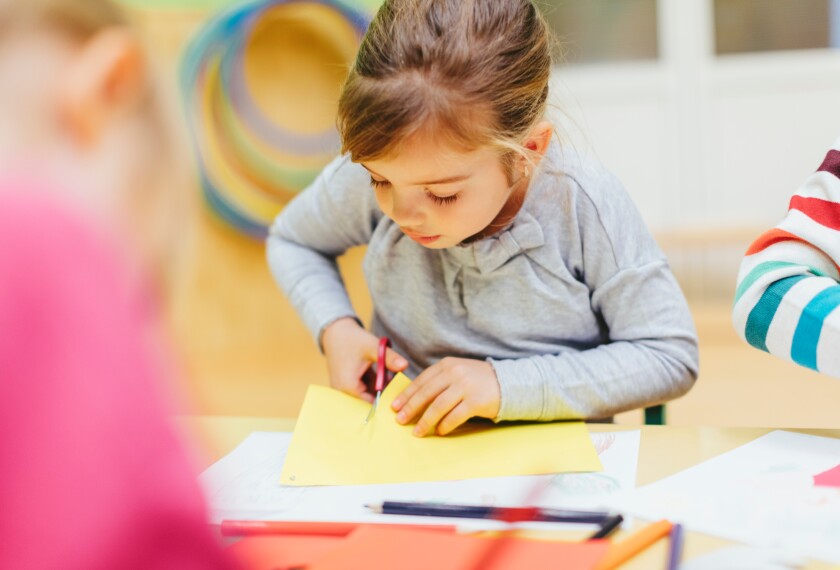Amid the stress and disruption of the pandemic, parents and caregivers have had less time and energy to engage their babies and toddlers in conversation—and the lack of talk already shows in their language skills.
New studies from Rhode Island Hospital and the nonprofit LENA Foundation find that infants born during the pandemic vocalize significantly less and engage in less verbal “turn-taking” behaviors found to be critical for language development. As those babies grow, experts worry they will need significant supports to be ready for school.
Since 2010, Sean Deoni, the director of the Advanced Baby Imaging Lab at the INSPIRE Center of Rhode Island Hospital, and his colleagues have tracked more than 1,700 Rhode Island families with infants. The researchers conduct regular cognitive and language development tests as well as brain scans as the children grow and monitor how the children are exposed to language in their earliest years of life.
During the pandemic, the lab was able to continue its assessments, but Deoni said he and his colleagues quickly realized their study population was changing.
“We began to notice anecdotally several months into the pandemic that kids seemed to be having a little greater challenge in doing their cognitive tests,” Deoni said. “Children just seemed to be taking a little bit longer to get through their assessments; they maybe weren’t as attentive or not performing as well as we normally had seen. And over time, those individual anecdotal statements became a chorus.”
By a year into the pandemic, the average cognitive performance of children ages 3 months to 3 years was the lowest it had been since the researchers had begun to measure it in 2010. For toddlers ages 16 months or younger, expressive and receptive language scores fell from about 90 points on a scale of 140 in 2020 to 60 in 2021 on normalized assessments of verbal skills. Moreover, neuroimaging data show babies born during the pandemic have had slower growth in white matter, the communication channels of the brain, compared to infants born in the years before the pandemic.
“It’s not that they start off low and they’ll slowly get back to [normal], but [they] actually seem to be decreasing as time is going on, which means that the cumulative impact of the COVID environment seems to be getting worse,” he said. “And this seems to be across the brain, impacting not just motor systems or later cognitive systems, but almost every neurodevelopmental system. So that’s alarming.”
Gaps of words and conversation
Both Deoni’s research and separate research by the LENA Foundation suggest these developmental delays may be sparked by less language engagement.
Thirty years ago, University of Kansas child psychologists Betty Hart and Todd R. Risley realized that infants’ language development hinges greatly on others engaging them in rich conversation about the world around them. Their , “Meaningful Differences,” estimated that by age 3, children in professional families heard more than three and a half times as many words every hour as children in families receiving welfare did—leading to a controversial but often-cited gap of 30 million words by the time the children started school.
But even more importantly, adults help infants build language skills by "—speaking in response to a baby’s coos or cries and then pausing to let the baby or toddler vocalize back to them. Parents often use exchanges like these to answer their children’s needs or encourage their interests.
In the three years before the pandemic, a 2-year-old in the Rhode Island study heard, on average, 100-140 words per hour, and had 35-50 conversational exchanges with the adults around them. By contrast, in 2020 and 2021, a 2-year-old heard about 20-70 words an hour and had 15-25 conversational exchanges per hour. Deoni also found toddlers during the pandemic spent a greater portion of their time watching television. (The .)
Jill Gilkerson, the LENA Foundation’s language research director, tracks infants’ language environment through a recording device attached to a harness. The infant or toddler wears the harness at home over several days, and the recorder is triggered by verbal sounds made by both the infant and others around her, screening out nonverbal sounds like burps.
Gilkerson found on average, that while vocalizations fell for all infants born after the pandemic, the drop was greatest for the poorest 25 percent of children. The lowest-income babies and toddlers fell from the 50th percentile to the 25th percentile in the frequency of their vocalizations, and from the 45th percentile to the 25th percentile in the number of conversational exchanges they had with caregivers.
Gilkerson said the pandemic stressed families in ways that could reduce their engagement: more harried parents—often with older siblings home—and fewer children in formal day care programs with teachers trained to engage them. Moreover, in many cases early-education teachers used face masks, which were intended to limit the spread of COVID but also made it harder for babies to see teachers’ expressions and hear their responses.
Gilkerson and Deoni both urged education leaders to partner with local early-childhood educators and parents to provide more language enrichment for children born during the pandemic.
For example, in a separate study, Gilkerson found that after families participated in a 10-week program to learn conversational strategies, their infants had an 8 percent increase in vocalizations and a 30 percent increase in conversational turns.
“The stark reality is we are going to have a generation of children who are going to start less ready for school,” Gilkerson said. “Kids are resilient and we know a lot of them can see a bounce back, but we want to start as early as possible. I worry about the children whose parents have fewer resources. It’s going to be harder to get that bounce back.”






